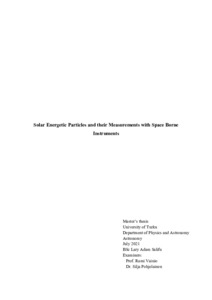Solar Energetic Particles and their Measurement with Space Borne Instruments
Lary, Salifu (2021-07-07)
Solar Energetic Particles and their Measurement with Space Borne Instruments
Lary, Salifu
(07.07.2021)
Julkaisu on tekijänoikeussäännösten alainen. Teosta voi lukea ja tulostaa henkilökohtaista käyttöä varten. Käyttö kaupallisiin tarkoituksiin on kielletty.
avoin
Julkaisun pysyvä osoite on:
https://urn.fi/URN:NBN:fi-fe2021080642321
https://urn.fi/URN:NBN:fi-fe2021080642321
Tiivistelmä
The study of our Sun and its various modes of activity is an important area of research in the field of space physics and heliophysics. These active phenomena such as solar flares and Coronal Mass Ejections are associated with energetic particles (protons, electrons, ions, etc.) which are released into our solar system and possess high speed. Some of these energetic particles are likely to reach Earth. In this work, I looked into the various types of solar particle events and their characteristics as well as how these energetic particle properties are measured using space borne instruments. Different instruments using different measurement techniques were also studied, which gives us information about the kind of energetic particles that are measured or detected by these different instruments. A design of a particle telescope, which employs the use of multiple detectors was studied in this work. The telescope had three Si-detectors, a foil material (Kapton polyimide film) and a caesium iodide (CsI) detector. The detector thicknesses were optimised in order to achieve a desired result. Thus in total the design had four detectors and an entrance foil. The thicknesses of the foil material and CsI detector were as well converted into their respective silicon range equivalence in order to optimise the layer thicknesses in the design. Particles are measured at different angles of incidence but for the purpose of this work, I looked at particles penetrating the detectors at 0⁰ and 25⁰ as the limiting values. The results show that the minimum energies a particle needs to penetrate the foil material at 0⁰ and 25⁰ are 4.97 MeV and 5.27 MeV respectively. The effective threshold energy of protons detected in the first detector (D1) is between these values. Furthermore the results give us the information that as the angle of incidence is increasing, the energy also increases steadily. The energy channel resolution for protons stopping in D1, D2 and D3 were 0.386, 0.355 and 0.374 respectively which was close to the desired value (0.4) set as a target of the design.
